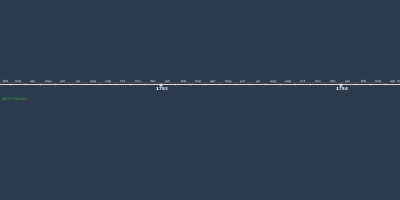16 mayo 1837 año - Panic of 1837
Descripción:
A financial crisis in the United States that touched off a major recession that lasted until the mid-1840s. Profits, prices, and wages went down while unemployment went up. Pessimism abounded during the time. The panic had both domestic and foreign origins. Speculative lending practices in western states, a sharp decline in cotton prices, a collapsing land bubble, international specie flows, and restrictive lending policies in Great Britain were all to blame. On May 10, 1837, banks in New York City suspended specie payments, meaning that they would no longer redeem commercial paper in specie at full face value. Despite a brief recovery in 1838, the recession persisted for approximately seven years. Banks collapsed, businesses failed, prices declined, and thousands of workers lost their jobs. Unemployment may have been as high as 25% in some locales. The years 1837 to 1844 were, generally speaking, years of deflation in wages and prices.The crisis followed a period of economic expansion from mid-1834 to mid-1836. The prices of land, cotton, and slaves rose sharply in these years. The origins of this boom had many sources, both domestic and international. Land sales and tariffs on imports were generating substantial federal revenues. Through lucrative cotton exports and the marketing of state-backed bonds in British money markets, the United States acquired significant capital investment from Great Britain. These bonds financed transportation projects in the United States. British loans, made available through Anglo-American banking houses like Baring Brothers, fueled much of the United States' westward expansion, infrastructure improvements, industrial expansion, and economic development during the antebellum era.
Improved transportation systems increased the supply of cotton, dropping the price it could fetch at market. Cotton prices were security for loans, and America's cotton farmers defaulted. Furthermore, in 1836 and 1837 American wheat crops suffered from Hessian Fly and winter kill, so the price of wheat in America increased greatly, causing American labor to starve.
When New York banks raised interest rates and scaled back on lending, the effects were damaging. Since the price of a bond bears an inverse relationship to the yield (or interest rate), the increase in prevailing interest rates would have forced down the price of American securities. Importantly, demand for cotton plummeted. The price of cotton fell by 25% in February and March 1837.
The Specie Circular of 1836 mandated that western lands could be purchased only with gold and silver coin. The intent was to curb speculation in public lands, but the circular set off a real estate and commodity price crash as most buyers were unable to come up with sufficient hard money or "specie" (gold or silver coins) to pay for the land.
The Deposit and Distribution Act of 1836 placed federal revenues in various local banks (derisively termed "pet banks") across the country. Many of these banks were located in western regions. The effect of these two policies was to transfer specie away from the nation's main commercial centers on the East Coast. With lower monetary reserves in their vaults, major banks and financial institutions on the East Coast had to scale back their loans, which was a major cause of the panic along with the real estate crash.
In 1842, the American economy was able to rebound somewhat and overcome the five-year depression, but according to most accounts, the economy did not recover until 1843. The recovery from the depression intensified after the California gold rush started in 1848, greatly increasing the money supply. By 1850, the U.S. economy was booming again.
Añadido al timeline:
fecha:
16 mayo 1837 año
Ahora mismo
~ 188 years ago
